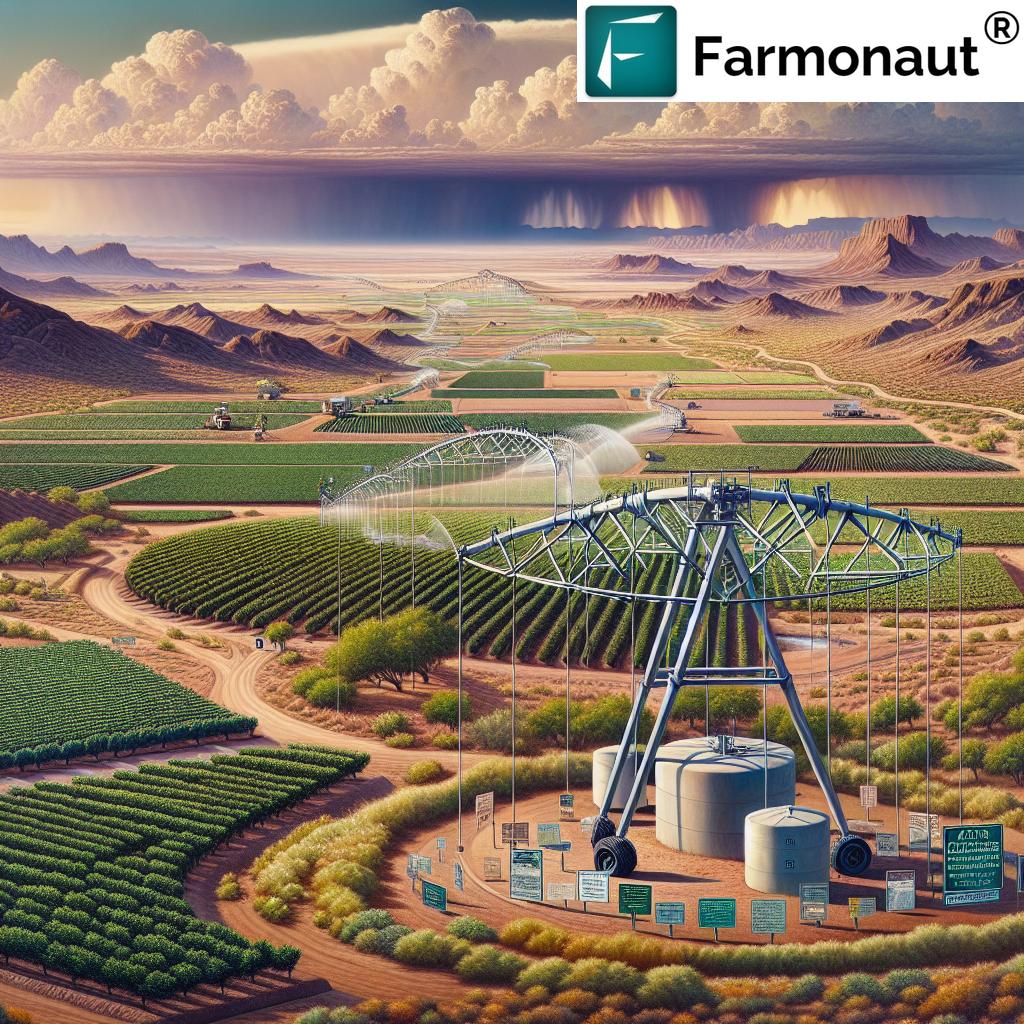Kansas Farmers Funding Freeze: 7 Urgent Impacts on Payments
The USDA funding freeze initiated in early 2025 sent shockwaves through the Kansas agricultural sector, touching everything from conservation efforts and rural energy development to vital payments due to farmers. As federal agricultural funding became entangled in bureaucratic review, those who had already initiated agricultural projects or entered government support contracts faced operational and financial uncertainty. Below, we analyze the most urgent impacts, the affected programs, the broader significance for rural communities, and how modern technology, like that offered by Farmonaut, equips stakeholders for such policy upheavals.
-
Farmonaut Carbon Footprinting
– Track, monitor, and reduce your farm’s emissions with real-time analytics, crucial for sustainability and compliance in today’s regulatory environment. -
Farmonaut Traceability Solutions
– Enhance food safety, supply chain transparency, and consumer trust with blockchain-validated traceability, essential for modern agribusiness. -
Farmonaut Fleet Management
– Optimize logistics, reduce fuel costs, and ensure operational efficiency across your agricultural fleet. -
Farmonaut Large-Scale Farm Management
– Manage extensive plantation data, resources, and remote field operations efficiently via our AI-powered, regularly updated satellite platform. -
Farmonaut Crop Loan & Insurance Interface
– Satellite-based verification streamlines agricultural finance and risk mitigation for farmers and lenders. -
Farmonaut Crop Plantation/Farm Advisory
– Access personalized, AI-driven insights for optimizing planting and resource use in agriculture.
Farmonaut API – Integrate satellite data into your own platforms for custom agricultural analytics.
API Developer Documentation – Full guides for deploying advanced monitoring, field insights, and weather integrations.
Background of the USDA Funding Freeze
In early 2025, the U.S. Department of Agriculture (USDA) implemented a comprehensive funding freeze as part of a broader federal review mandated by the Office of Management and Budget (OMB). This decision had instant and wide-reaching effects on the Kansas agriculture sector. Payment support for vital rural development, conservation projects, and energy initiatives was abruptly halted—even for projects already underway.
Notably, the freeze targeted programs administered through the Natural Resources Conservation Service (NRCS), impacting water management, conservation, and rural energy development projects. This stoppage came as a shock to Kansas farmers and rural organizations that had entered into contracts and initiated projects with the expectation of timely governmental support.
- Purpose of the Freeze: To ‘review’ and audit federal agricultural funding, ensuring spending aligns with new policy priorities and budget constraints.
- Programs Directly Affected: Conservation projects, renewable energy initiatives, and numerous rural economic development programs—many of which form the backbone of sustainable agriculture in Kansas.
- Geographical Focus: Kansas was one of the most affected states due to the high adoption rate of such federally supported projects.
The sudden freeze on payments upended the planning, financial stability, and operational momentum for thousands of producers and rural organizations statewide—prompting widespread concern, legal challenges, and intense scrutiny from policymakers.
Impacts Analysis Table: USDA Funding Freeze
The following table summarizes the seven urgent impacts of the USDA funding freeze on Kansas farmers and rural communities. Each row highlights the affected area, number of stakeholders, financial repercussions, severity, and a brief description for quick comprehension.
| Impact Area | Estimated Stakeholders Affected | Estimated Financial Impact (USD) | Severity Level | Brief Description |
|---|---|---|---|---|
| Payments to Farmers | 3,400+ | $50M+ | High | Delayed contract payments and reimbursements cause cash-flow disruptions. |
| Rural Energy Projects | 850+ | $25M+ | High | REAP-supported solar and renewable projects halted or unreimbursed. |
| Conservation Efforts | 2,000+ | $18M+ | High | Projects for erosion control, soil improvements, and sustainable farming frozen. |
| Water Management Projects | 440+ | $10M+ | Medium | Pipeline, wells, and irrigation upgrades stalled mid-completion. |
| Agricultural Education & Resources | 210+ | $2M+ | Medium | STEM and conservation education initiatives paused; youth/staff impacted. |
| Rural Community Support Programs | 1,000+ | $7M+ | Medium | Job, food security, and local health programs suspended in rural counties. |
| Legal & Policy Uncertainty | Entire sector | Unknown (Opportunity Cost) | High | Court battles, delayed restoration create planning paralysis for farming operations. |
7 Urgent Impacts on Kansas Farmers’ Payments
The challenges caused by the USDA funding freeze extend into every corner of Kansas agriculture. Below we detail, with examples and explanations, the seven most urgent impacts undermining farm and rural sector stability—focusing on financial, operational, and community outcomes.
1. Kansas Farmers’ Financial Impact: Delayed Payments and Contract Disruption
Central to this crisis is the freeze on payments for those with active contracts and assistance agreements. Many Kansas farmers had advanced funds, purchased materials, and even installed upgrades like solar panels or fencing—all with the expectation of federal reimbursement (REAP, NRCS programs).
- Farmers are left in financial limbo: Funding for work already completed has been suspended, straining farm capital flows.
- Example: A $600,000 rural energy project initiated and installed by a Kansas farmer remains unpaid due to the freeze.
- Trust in government-backed agricultural support contracts is shaken, threatening future program participation.
2. Rural Energy Development: Renewable Energy Projects Stalled
Programs like the Rural Energy for America Program (REAP) require farmers to invest upfront—only to seek a federal reimbursement of up to 50% afterward. The freeze abruptly halted reimbursements, leading to acute liquidity problems and halting projects aimed at reducing costs and offsetting carbon emissions in Kansas.
- Solar and wind initiatives, which were crucial for rural cost savings and environmental compliance, are at risk of abandonment.
- This also impedes the adoption and growth of renewable energy for farms statewide.
- Financial risk increases for rural innovators and early adopters.
Related keyword focus: “rural energy development programs”, “renewable energy for farms”, “Kansas farmers financial impact”
3. Conservation Program Freeze: Sustainable Practices Jeopardized
The conservation program freeze impeded a vast array of sustainable farming initiatives—ranging from wildlife habitat restoration to cover cropping and wind erosion mitigation. Kansas, an agricultural powerhouse, is particularly exposed to soil erosion and climate-driven risks.
- Suspension of funding for conservation practices leaves soil and water at greater risk, especially in critical regions prone to dust storms and drought.
- Projects for improving soil health and preventing natural resource degradation are paused or incomplete.
- Baseline sector-wide sustainability targets are threatened.
4. Water Management Projects: Infrastructure Upgrades Stalled
Many Kansas farms were midway through critical upgrades—new wells, additional water lines, drip irrigation, and erosion-resistant fencing. The funding freeze leaves producers unable to complete work, jeopardizing operational efficiency and resilience against drought.
- Farmers face potential crop yield loss and resource wastage without effective water systems.
- Interruptions increase the risk of land degradation and future financial losses.
5. Agricultural Education Programs Pause: Farm Organizations and Youth at Risk
With more than half of their budget tied to federal contracts, organizations like Kansas City Farm School were forced to pause much-needed education and training initiatives for emerging farmers.
- Program participants and staff face job insecurity and disrupted learning.
- Future leaders in Kansas agriculture lose opportunities for skills development in sustainable and climate-smart farming.
- Community engagement and local food initiatives struggle without stable financial support.
6. Rural Community Support: Grant Uncertainty for Local Organizations
Grants funded under the Inflation Reduction Act and other federal sources, such as those awarded to the Healthy Bourbon County Action Team, had their communications and funding flow pause. This uncertainty hit rural development, job creation, and public health efforts squarely.
- County-level projects supporting rural health, food security, and economic opportunity are delayed.
- Grant recipients are unsure how, or whether, planned initiatives will proceed.
7. Legal, Political, and Policy Confusion: A Precedent for Agricultural Funding Risk
The executive freeze, subsequent legal challenges, and slow restoration of funds created a “planning paralysis.”
- Legal interpretations are forced to untangle which payments and projects qualify for restoration.
- The line between executive review and congressional control over agricultural budgeting is tested, adding risk to all future contracts.
- Until full clarity is restored, uncertainty undermines farmers’ willingness to innovate or enter new federal initiatives.
Broader Implications for Rural Communities
The pain of the USDA funding freeze is most acutely felt in rural communities, where agriculture remains the primary economic and social backbone. Disruption of payments, energy initiatives, and grant projects reverberates far beyond individual farms:
- Economic Shockwaves: Contract workers, suppliers, and agri-services depend on predictable payments in the farming cycle. Ripple effects impact hundreds of regional jobs.
- Infrastructure Setbacks: Water management and renewable energy projects are often concentrated in rural Kansas, and their suspension delays essential community modernization.
- Health and Food Security Risks: Several rural community support programs, including food distribution, nutrition projects, and health education, were funded through federal grants now under review. Vulnerable populations are disproportionately impacted.
- Reduction in Research and Innovation: Without ongoing funding, organizations studying soil conservation, carbon offsetting, and regenerative farming practices are unable to continue their work—hindering statewide agricultural progress.
- Long-term Trust Erosion: Many farmers may hesitate before enrolling in future government programs, fearing unpredictability and risk of interrupted support.
Which Federal Programs and Initiatives Were Affected?
The freeze’s impact on federal agricultural funding was felt across multiple pillars vital to Kansas agriculture:
-
Rural Energy for America Program (REAP):
- Provides critical assistance for rural energy development programs. Farmers who installed solar panels or energy-efficient upgrades were left unpaid, undermining both financial health and environmental carbon reduction goals.
-
Conservation Programs (EQIP, CSP, ACEP, NRCS):
- Supports sustainable farming practices, water and soil conservation, and natural resource management. Project interruptions can harm land health and future productivity.
-
Agricultural Education Initiatives:
- Organizations teaching sustainable farming, climate resilience, and resource efficiency (Kansas City Farm School, local STEM groups) face severe budget shortfalls without federal funds.
-
Community Health and Rural Development Grants:
- Efforts to improve job training, food distribution, and rural population health, such as through the Healthy Bourbon County Action Team, have suffered delays and resource uncertainty.
-
Water Management and Infrastructure Projects:
- NRCS-funded upgrades—including fencing, new wells, and irrigation systems—are now incomplete, forcing some farms to operate at a loss or under suboptimal conditions.
How Advanced Technology Bolsters Agricultural Support During Funding Uncertainty
In a climate where traditional support structures can be undermined by sudden federal policy shifts, technology-driven solutions become even more essential for risk management, planning, and resilience. At Farmonaut, we are committed to helping not just Kansas farmers, but agricultural stakeholders worldwide, navigate an increasingly unpredictable landscape with tools that:
- Real-Time Field Monitoring: Using satellite-based remote sensing, our platform delivers actionable crop health, soil moisture, and biomass data. Farmers can make evidence-based decisions in uncertain times and respond swiftly to operational hiccups.
- Resource Optimization: Features like AI-driven irrigation and fertilizer advice reduce unnecessary resource use, especially when cash flow is restricted by delayed payments.
- Carbon Footprinting: We enable carbon tracking so farms can independently validate and optimize their environmental performance—useful when government assistance is uncertain or tied to strict compliance.
- Blockhain Traceability: Strengthen trust between producers, buyers, and consumers with transparent reporting, regardless of political context or programmatic disruption—with more on our traceability products.
- Financing & Insurance: With satellite-based verification, farmers can access private crop loans and insurance, lessening overreliance on unpredictable public reimbursement cycles.
- Fleet and Resource Management: Optimize vehicles and agricultural machinery deployment in times of fluid budgets, ensuring critical work like wells construction and conservation projects can continue as efficiently as possible. Learn how our fleet management tools support this.
These solutions empower all stakeholders, even as budgets and funding streams experience disruption, to maintain sustainable, productive farming operations.
Current Status and Future Outlook for Kansas Agricultural Funding
As of June 2025, there have been some positive developments but significant uncertainty lingers:
- Legal Reversal: Federal courts temporarily blocked the freeze at the end of January. The Biden administration subsequently rescinded the broader order, partially restoring programmatic funding.
- Partial Restoration: A “first wave” of previously frozen funds—especially for the Environmental Quality Incentive Program (EQIP), Conservation Stewardship Program (CSP), and Agricultural Conservation Easement Program (ACEP)—has been disbursed. However, timelines for full restoration remain unclear.
- Ongoing Advocacy: Agricultural organizations and farm associations are lobbying for swift, unambiguous reinstatement of all owed payments. Advocacy now focuses on the need for predictability and trust in state and federal program delivery.
- Policy Debate: Intense discussion continues about the balance between executive discretion and congressional authority over agricultural budgeting, setting precedents for future administrative changes.
Farmers and rural leaders stress that the cost of this freeze endures well beyond the immediate financial shortfall—eroding confidence in government contracts and programs that underpin sector-wide sustainability and long-term food security.
Kansas Farmers Funding Freeze: FAQ
Which Kansas counties were most severely impacted by the USDA funding freeze?
While the freeze affected rural and agricultural counties statewide, regions with high concentrations of federally supported conservation, water management, or renewable energy projects—such as Ashland, Bourbon, and adjacent counties—were among the most severely impacted.
Will all frozen agricultural projects in Kansas eventually receive the funds they were promised?
As of June 2025, some funds are being released for key programs; however, delays and bureaucratic hurdles persist. Not all projects have a guaranteed full restoration timeline, and ongoing advocacy is required to hold agencies accountable.
What types of farm operations were most vulnerable to the suspension?
Livestock producers, conservation project participants, and farms investing in rural energy development (solar, wind, infrastructure) were particularly exposed, given their reliance on upfront expenditures with the expectation of later government reimbursement.
Are direct cash payments like Social Security affected?
No; the freeze targeted agricultural, conservation, and rural development payments, not entitlement programs like Social Security or Medicare.
How can farmers in Kansas and elsewhere build resilience against such funding freezes in the future?
Diversifying risk with advanced farm management technology—utilizing tools for independent resource monitoring, production optimization, and alternative financing—improves operational agility and helps mitigate the effects of sudden funding or policy disruptions.
What should organizations and farm groups do to prepare for similar federal reviews?
Maintain meticulous documentation for all contracts, seek clarity on program criteria in advance, and invest in solutions that offer independent verification and traceability—such as blockchain, satellite, and AI-driven tools.
Conclusion: Lessons for Kansas Agriculture After the USDA Funding Freeze
The 2025 USDA funding freeze has laid bare the vulnerabilities in the foundation of Kansas agriculture and rural economic development. Conservation efforts, water management projects, and rural energy development programs—all crucial for a sustainable agricultural future—prove fragile if not adequately protected from political and budgetary volatility.
With only partial restoration of federal agricultural funding so far, the need for resilient and diversified approaches has never been more urgent. Adopting farm management systems that leverage the latest technology (from remote sensing and AI advice to blockchain traceability and carbon tracking) is not just a matter of efficiency—it is a safeguard against systemic risk.
As Kansas, and the broader U.S. agricultural sector, work toward recovery and future-proofing, the lesson is unmistakable: a strong combination of trusted public policy and private technological innovation is essential for the health, sustainability, and prosperity of our farmers and rural communities.





















